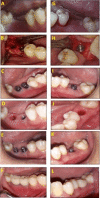The Influence of Low-Level Laser Therapy on CBCT Radiographic and Biochemical Profiles of Type II Controlled Diabetic Patients After Dental Implant Insertion: A Randomized Case-Control Study
- PMID: 37102010
- PMCID: PMC10123229
- DOI: 10.7759/cureus.36559
The Influence of Low-Level Laser Therapy on CBCT Radiographic and Biochemical Profiles of Type II Controlled Diabetic Patients After Dental Implant Insertion: A Randomized Case-Control Study
Abstract
Background Low-level laser treatment (LLLT) was thought to increase bone quality during osseointegration when combined with dental implants. However, there is no sufficient information on its impact on dental implants in diabetics. Osteoprotegerin (OPG) has been described as a marker for bone turnover to determine implant prognosis. The current research aims to evaluate the effect of low-level laser therapy (LLLT) on bone density (BD) and osteoprotegerin levels in peri-implant crevicular fluid (PICF) in type II diabetic patients. Methods This study comprised 40 individuals with type II diabetes mellitus (T2DM). Implants were randomly placed in 20 non-lasered T2DM patients (control) and 20 lasered T2DM patients (LLLT group). At the follow-up stages, BD and OPG levels in the PICF were evaluated in both groups. Results Significant variations were shown among control and LLLT groups concerning OPG level and BD (p≤0.001). OPG was significantly decreasing with follow-up points (p≤0.001). There was a significant decrease in OPG with time in both groups with a higher decrease in the control group. Conclusion LLLT is promising in controlled T2DM patients due to its outstanding influence on BD and estimated crevicular levels of OPG. Regarding its clinical significance, LLLT significantly improved bone quality during osseointegration on dental implants in T2DM. LLLT is considered potentially important for T2DM patients during implant placement. Trial registration The study was registered on ClinicalTrial.gov under registration number NCT05279911 (registration date: March 15, 2022) (https://clinicaltrials.gov/ct2/show/NCT05279911).
Keywords: bone density; implant; low-level laser therapy; opg; osteoprotegerin; type ii diabetes.
Copyright © 2023, Attia et al.
Conflict of interest statement
The authors have declared that no competing interests exist.
Figures






References
-
- Influence of placement depth and abutment connection pattern on bone remodeling around 1-stage implants: a prospective randomized controlled clinical trial. Palaska I, Tsaousoglou P, Vouros I, Konstantinidis A, Menexes G. Clin Oral Implants Res. 2016;27:0–56. - PubMed
-
- Osseointegrated implants in the treatment of the edentulous jaw. Experience from a 10-year period. Brånemark PI, Hansson BO, Adell R, Breine U, Lindström J, Hallén O, Ohman A. https://pubmed.ncbi.nlm.nih.gov/356184/ Scand J Plast Reconstr Surg Suppl. 1977;16:1–132. - PubMed
-
- Effect of diabetes in osseointegration of dental implant - a review. Pavya G, Babu NA. Biomed Pharmacol J. 2015;8:353–358.
-
- Relations between the bone density values from computerized tomography, and implant stability parameters: a clinical study of 230 regular platform implants. Turkyilmaz I, Tumer C, Ozbek EN, Tözüm TF. J Clin Periodontol. 2007;34:716–722. - PubMed
Associated data
LinkOut - more resources
Full Text Sources
Medical
